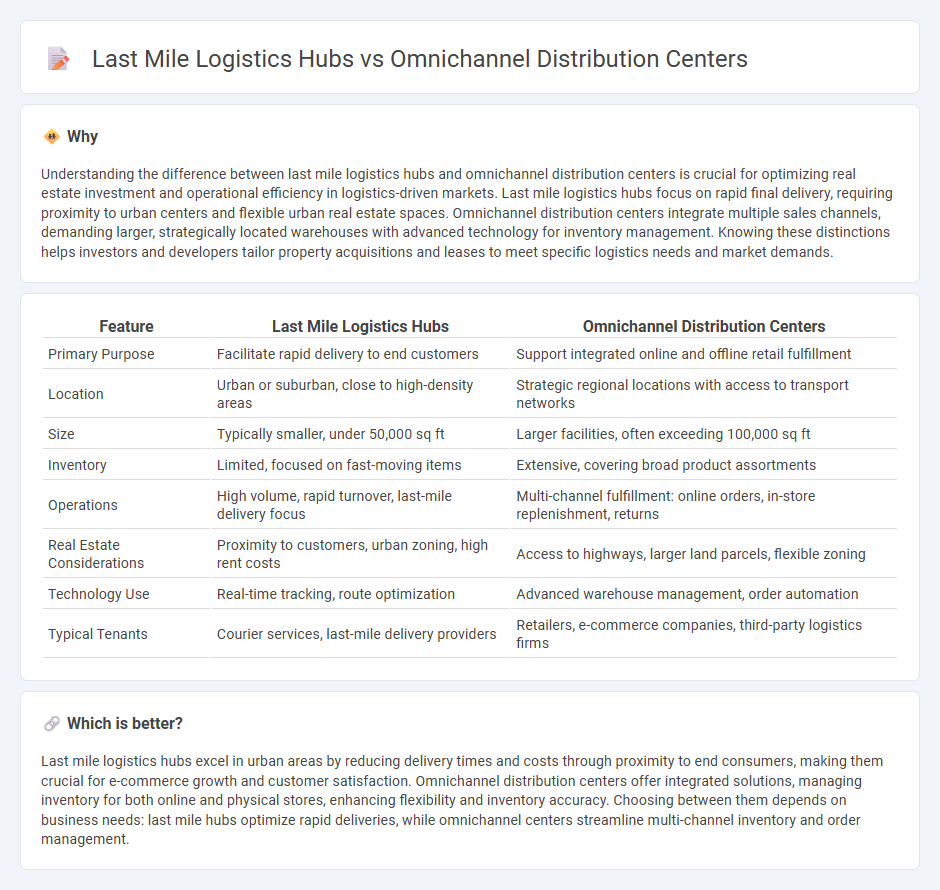
Last mile logistics hubs optimize delivery speed by positioning inventory close to urban centers, enhancing parcel distribution efficiency. Omnichannel distribution centers integrate multiple sales channels, supporting both online and in-store fulfillment to streamline inventory management and customer service. Explore how tailored logistics strategies can transform real estate investments in supply chain networks.
Why it is important
Understanding the difference between last mile logistics hubs and omnichannel distribution centers is crucial for optimizing real estate investment and operational efficiency in logistics-driven markets. Last mile logistics hubs focus on rapid final delivery, requiring proximity to urban centers and flexible urban real estate spaces. Omnichannel distribution centers integrate multiple sales channels, demanding larger, strategically located warehouses with advanced technology for inventory management. Knowing these distinctions helps investors and developers tailor property acquisitions and leases to meet specific logistics needs and market demands.
Comparison Table
| Feature | Last Mile Logistics Hubs | Omnichannel Distribution Centers |
|---|---|---|
| Primary Purpose | Facilitate rapid delivery to end customers | Support integrated online and offline retail fulfillment |
| Location | Urban or suburban, close to high-density areas | Strategic regional locations with access to transport networks |
| Size | Typically smaller, under 50,000 sq ft | Larger facilities, often exceeding 100,000 sq ft |
| Inventory | Limited, focused on fast-moving items | Extensive, covering broad product assortments |
| Operations | High volume, rapid turnover, last-mile delivery focus | Multi-channel fulfillment: online orders, in-store replenishment, returns |
| Real Estate Considerations | Proximity to customers, urban zoning, high rent costs | Access to highways, larger land parcels, flexible zoning |
| Technology Use | Real-time tracking, route optimization | Advanced warehouse management, order automation |
| Typical Tenants | Courier services, last-mile delivery providers | Retailers, e-commerce companies, third-party logistics firms |
Which is better?
Last mile logistics hubs excel in urban areas by reducing delivery times and costs through proximity to end consumers, making them crucial for e-commerce growth and customer satisfaction. Omnichannel distribution centers offer integrated solutions, managing inventory for both online and physical stores, enhancing flexibility and inventory accuracy. Choosing between them depends on business needs: last mile hubs optimize rapid deliveries, while omnichannel centers streamline multi-channel inventory and order management.
Connection
Last mile logistics hubs and omnichannel distribution centers are strategically located within real estate developments to optimize supply chain efficiency and reduce delivery times. These facilities leverage commercial real estate assets in urban areas to support rapid inventory turnover and seamless integration of online and offline retail channels. Proximity to residential neighborhoods and transportation infrastructure is critical in maximizing the value of these distribution centers in the real estate market.
Key Terms
Location Strategy
Omnichannel distribution centers prioritize proximity to major transportation networks and urban centers to efficiently handle diverse inventory for both online and in-store sales. Last mile logistics hubs focus on ultra-local placement within dense population areas to ensure rapid delivery and reduce transit times. Explore detailed location strategies to optimize supply chain performance and customer satisfaction.
Facility Design
Omnichannel distribution centers prioritize flexible layouts to handle diverse product flows and support direct-to-consumer fulfillment alongside bulk shipments, incorporating advanced automation and real-time inventory management systems to optimize space and efficiency. Last mile logistics hubs emphasize compact, strategically located facilities designed for rapid order processing, sorting, and delivery within urban environments, often integrating sustainable features and scalable infrastructure to accommodate fluctuating demand patterns. Explore these facility design strategies to enhance supply chain responsiveness and customer satisfaction.
Tenant Mix
Omnichannel distribution centers prioritize a diverse tenant mix, combining retailers, wholesalers, and e-commerce platforms to streamline inventory management across multiple sales channels. Last mile logistics hubs typically host tenants specializing in delivery services, local couriers, and fulfillment companies focused on rapid parcel sorting and dispatch within urban areas. Explore detailed analyses of tenant composition and operational synergies to understand their distinct roles in supply chain optimization.
Source and External Links
Omnichannel Distribution | ABCO Systems - Omnichannel distribution centers use advanced automation and technology to synchronize inventory visibility and optimize order management efficiently across all sales channels, including online and physical stores, ensuring seamless fulfillment.
Omnichannel Shipping Strategies - DCL Logistics - Omnichannel distribution centers enable seamless handling and fulfillment of orders from multiple sales channels in one location or network, improving delivery times, reducing costs, and enhancing customer experience from order to delivery.
A Business Owner's Guide To Omnichannel Supply Chain - Surgere - Advanced omnichannel distribution centers incorporate smart warehouse technologies, centralized inventory visibility, and flexible fulfillment from any network node to optimize speed and efficiency across all channels in real time.
 dowidth.com
dowidth.com